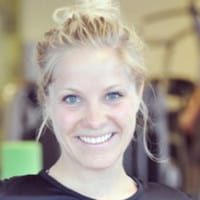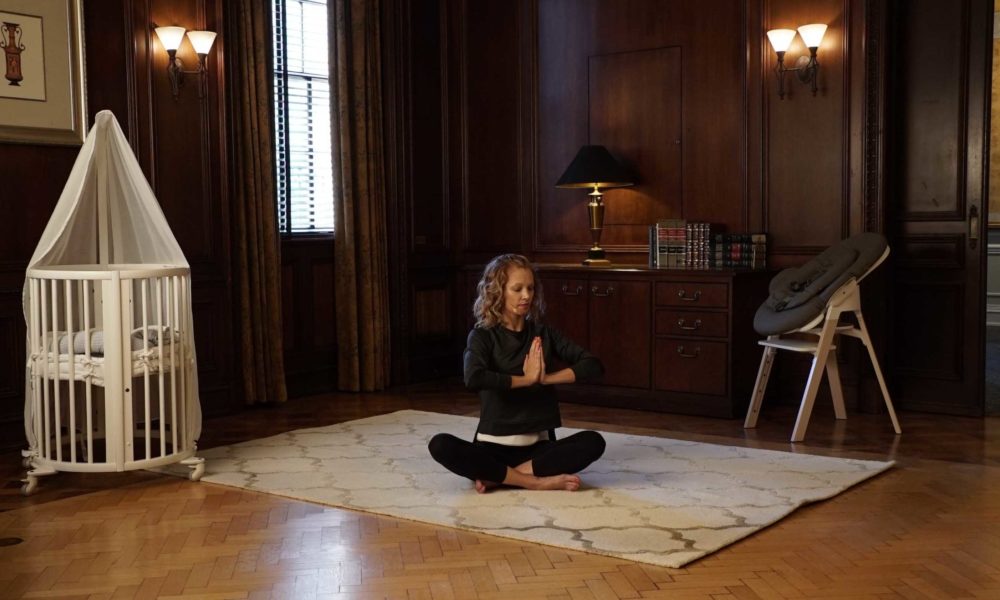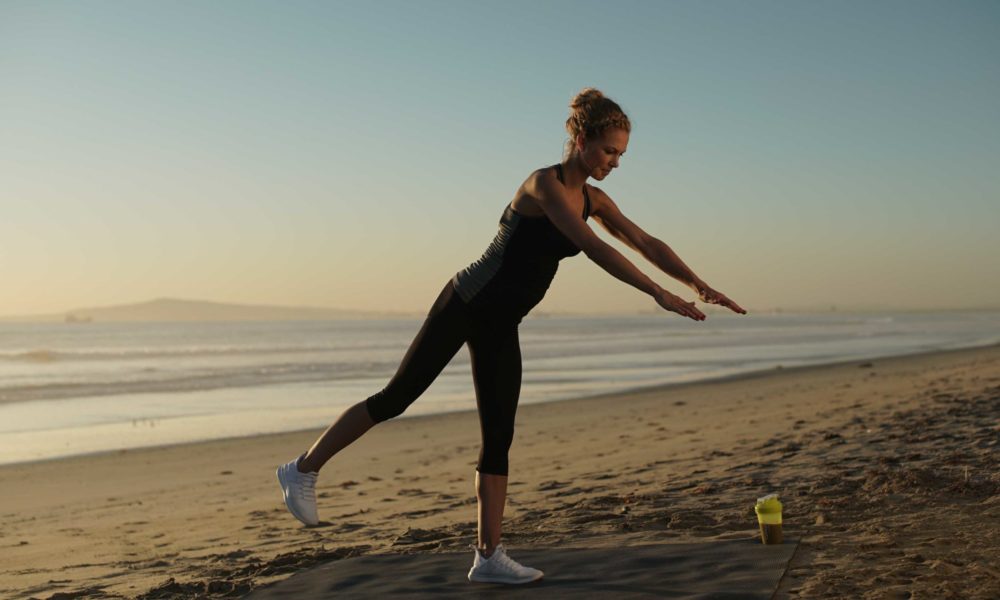Have you had a C-section and are unsure if and when you can, should, or may begin exercising, or even your fitness routine again? It doesn’t matter if you chose to have a C-section, or had a medically necessary planned C-section, or an emergency C-section. Not to mention the emotional pain you might have, the physical surgery is also very stressful for your body. Now your body needs time and rest to recover and heal. But does that mean you have to wait a long time after a C-section to get back into your fitness routine? If so, how long exactly? Or are there even exercises that stimulate the healing process?
Can I exercise after a C-section?
You should give your body some rest shortly after this surgical procedure, but even in the first few weeks after birth, special gentle exercises such as pelvic floor and abdominal breathing can speed up healing also after a c-section!
When can I start exercising again after a C-section?
During the first weeks after birth, pelvic floor and abdominal breathing exercises will help you to restrengthen your body. After about 6-8 weeks, you can start with gentle postpartum recovery. However, be sure to wait for the official “okay” from your doctor before starting the program.
What exercises are especially good after a cesarean section?
- Activation of the pelvic floor layers through pelvic floor breathing
- Diaphragmatic breathing (abdominal breathing) to activate the abdominal fascia
- Venous pump to stimulate blood return and reduce water retention
- Upper Body stretching to prevent calluses in the scar
- Mobility exercises on all fours such as cat-cow
- …
Is postpartum recovery after a caesarean section necessary at all?
Yes! Definitely, because even if your pelvic floor is “spared” during birth, it was already heavily loaded during pregnancy due to the weight of the uterus and the stretching of the pelvis over a long period of time. Therefore, you should definitely rebuild your pelvic floor muscles. A weak pelvic floor can lead to incontinence, lowering of the pelvic organs, poor posture, etc.
Especially the abdominal muscles were heavily strained during the cesarean section and should be slowly rebuilt afterwards starting with gentle abdominal breathing.
First of all…
No matter when you start your return to your fitness routine, you can already be incredibly proud of your body, because just like during pregnancy, your body is doing a great job here!
It is in a state of emergency after the birth. And thanks to the extreme hormone release, it can heal much faster than after a comparable surgery that a non-pregnant woman would have. That is, while your body would normally be busy with such a serious operation for much longer, it is now healing just like after a vaginal birth in quite a short time for this type of injury….
When is a cesarean section completely cured?
Most postpartum recovery courses start 6-8 weeks after the birth. By the way, it does not mean that the wounds of a cesarean section are completely healed after 6-8 weeks! The scar in particular often pinches or hurts much longer.
But does that mean that maybe you should wait longer until the pain is completely gone? And you no longer feel anything from the scar?
It is probably true that except for the scar, which still looks quite fresh, it may already look healed from the outside, but the internal wounds usually take longer to heal.
In the case of a normal cesarean section, you can also start gentle postpartum exercises after 6-8 weeks. However, be sure to wait until you have the official “okay” from your doctor.
It is also important that you do not overstrain your body. Nevertheless, it must be stimulated at the same time! It is therefore important to find the right balance.
As with a spontaneous birth, your body needs much longer after a cesarean section to fully recover. Your body took 40 weeks to prepare for birth, and now please make sure you allow the same amount of time to recover. If you start exercising too early, it can have serious consequences for you. Constant consultation with your doctor is crucial. And yet, postpartum gentle fitness routine and an introduction to a fitness program after a certain period of time are essential.
"Give your body the time it needs."
"Once the scar is no longer open (approximately after 2-3 weeks) you should start massaging and touching it regularly to speed up the healing process. It is best to use oil for this procedure. If you feel a pulling sensation, don't worry: it's normal, with any injury it takes a while to heal completely, so give your body time."

Anna Weiß
Can I start exercising in the first weeks after birth with a c-section?
It is important that you start with light movements after the birth, so that your body is strengthened again and you activate its self-healing powers.
Therefore, you should already start doing exercises during the first weeks after birth.
Especially in the first six weeks, in German-speaking countries usually you have a very good midwife who will do such exercises with you. But if you do not have this, or you want to do something additional, our postnatal phase 0 is going to help you.
Most of the exercises you can do lying down or even in bed. And thus start with first pelvic floor stimulation and with breathing exercises. Our MOVE IT MAMA Special 15 workout has been developed exactly for this phase 0 and includes mommy exercises, which also accelerate the healing process after a cesarean section. The focus is not on getting rid of the baby belly, but on gradually rebuilding the pelvic floor muscles, reteaching the body to breathe properly and accelerating the movement of the internal organs to their original position.

What exercises are particularly suitable after a cesarean section?
These special exercises support the healing process:
- Diaphragmatic Breathing (=Abdominal Breathing): Diaphragmatic breathing is the first and best postnatal technique women should use immediately after birth. Breathing supports the postpartum healing process by helping you regain a sense of your abdominal muscles as well as your pelvic floor muscles.1. inhale: apex pulls upward while pubic and tailbone gently push downward into the floor. Inhale until the abdomen curves properly round.
2. exhale: while closing body openings, perhaps imagine that you are pulling something, e.g. a tampon, upwards. Even if you don’t feel this again, you are still getting the pelvic floor to slowly tense up again. On the next exhalation bring the ischial tuberosities together and towards the coccyx. For the third breath, pull the belly button and tailbone inward toward the top.
"Proper breathing lays the foundation for healing and strengthening the center of the body. This is how you specifically activate the abdominal fascia."

Anna Weiß
- Pelvic floor stimulation: sit cross-legged (or any other position comfortable for you)
1. Inhale: relax all the pelvic floor layers into the floor.
2. exhale: pull all pelvic floor layers upwards and inwards. Imagine you are unwinding a yoyo.(For more details on the pelvic floor layers, see our blog article here). - Triangle Stretch: Sit cross-legged (or another position that is comfortable for you). Vertex pulls upward while pubic and tailbone gently push down toward the floor. Interlace your hands above your head. Elbows push back, shoulder blades pull together. From here, pull one elbow to the side while the other points as straight up in the air as possible. In this posture, pull the elbows as far apart as possible and hold for three to five deep breaths, then switch sides.
“From 4 weeks after the operation, you may and should feel free to go into extension and hyperextension here, in order to stretch the hub in all directions to those. In this way you avoid calluses.”

Anna Weiß
There are also other exercises such as mobility exercises on all fours and the venous pump (i.e. stimulating the blood return). This is essential for a quicker recovery and helps to remove any water that may have accumulated in your leg. Thus you alleviate complaints such as swollen feet. In the following article for Fit for Fun “The first weeks after birth and re-entry into fitness” I explain in detail which exercises are particularly suitable for the first weeks after birth and how to perform them exactly.
Is postpartum recovery necessary after a c-section?
Perhaps you are wondering whether a class for postpartum recovery is necessary at all, because the pelvic floor is not put under extreme strain, especially during vaginal childbirth. You have been spared this strain, but your pelvic floor is still being put to a test during pregnancy. The weight of the uterus with the baby and the stretching of the pelvis over a longer period of time puts a lot of pressure on the pelvic floor. By cutting the abdominal muscles during surgery, the connection to the pelvis becomes unstable, so it is essential to gradually rebuild a sense of the pelvic floor. A weak pelvic floor can lead to incontinence, lowering of the pelvic organs, back pain and poor posture.
And so, even after a C-section, it is especially important that you re-learn how to properly target, activate, and relax your pelvic floor.
Above all, the abdominal muscles are heavily strained during the cesarean section, so you should definitely strengthen them again slowly, starting with the so mentioned gentle abdominal breathing (diaphragm breathing)followed by strengthening the deeper core muscles. Please avoid any straight crunches for a couple more months!!
Is the recovery after a cesarean section different from the recovery after a vaginal birth?
In principle, you can attend a normal recovery course. However, the so-called “postpartum recovery after cesarean section” specifically addresses the special requirements. In special courses, new moms learn how to strengthen the stressed tissue structures in the abdomen and pelvic floor – always taking into account the C-section scar, of course.
In principle, moms who have had a cesarean section are also taken into account in normal postnatal classes. However, if a course is offered specifically on the topic of cesarean section, you will of course find yourself even more among like-minded people and accordingly you may feel even more comfortable here. Just ask.
Our MOVE IT MAMA postnatal workouts, are designed in a way to fulfill your needs no matter if c-section or vaginal birth.
Is there a postnatal recovery at MOVE IT MAMA?
Of course we also have a phase in our MOVE IT MAMA program specifically for postnatal recovery: the postnatal phase 1. This begins as soon as you have the official “okay” from your doctor to start your fitness program again.
Unlike the “normal postnatal recovery classes” with a midwife, a physiotherapist or even a fitness trainer, you will also find the first workouts in the areas of whole body strengthening, cardio, crisp butt and stretching in this phase.
If you are unsure, of course, consult your doctor, but in principle, after his official approval, you can also start with these exercises after a cesarean section with caution.
To be on the safe side, you can also completely omit the dumbbells and mini bands that we use in some workouts.
MOVE IT MAMA also has workouts for postnatal abdominal exercises and pelvic floor strength.
So in phase 1 you will find exercises with a light load from all areas. With phases 2&3 the intensity of the training increases, the great thing is: you can always adapt the exercises to your individual level and therefore both a sport beginner and a sport expert feel picked up by our courses.
Are there any exercises I should definitely avoid after a C-section?
Oh, just like after a vaginal birth, it is also important to postpone certain exercises to a later point in time after a cesarean section, as the healing of your body’s center and thus your pelvic floor and abdominal muscles as a whole is now in the foreground. Only when these have been strengthened can you start with exercises that put a lot of strain on this area. In particular we are talking about :
- Bouncing and jumping
- Jogging
- heavy lifting / weight training
- jerky movements
- abdominal training of the straight abdominal muscles through crunches etc.
It is important to always listen to your body, if an exercise doesn’t feel good you should definitely stop it and not overload your body. If this is the case, minor internal injuries can occur, leading to adhesions in the abdomen or the cesarean scar can open up.
Often this can be difficult to implement, as some moms already have an older child and housework calls. Be sure to get help from your partner, family or friends for the first few weeks so that you can recover well and so you can also be there for your little one(s) much faster with renewed strength!
In any case, you should do all exercises with bodyweight only at first instead of dumbbells. And then it honestly depends on the individual fitness and progress from when you can use dumbbells again, so you can work with additional weight again. Start here with one to two kilos of dumbbells, and only towards the end of postnatal phase 1, which covers a period of 11 weeks after the exercises in the first weeks after birth are over.

Our MAMA’S LITTLE MIDDLE series is specially developed so that you do not actively train the straight abdominal muscles in phase 1 anyway. Here we gently stimulate the deeper abdominal muscles, which is also helpful for healing after a cesarean section, but if you feel pain, reduce the intensity and the number of repetitions!
Mommy, I hope I was able to motivate you to do some gentle exercises within the first few weeks are essential even after a C-section. So listen to your body, find the right balance between rest and working out and stay in constant consultation with your doctor. MOVE IT MAMA accompanies you and helps you to recover faster. So don’t be afraid to press the button and start postnatal phase 0!
Because as always:
Keep it Moving,
Your Birte.
Try move it mama 7 days for free
We give you a trial week in which you can test MOVE IT MAMA free of charge and without obligation.
